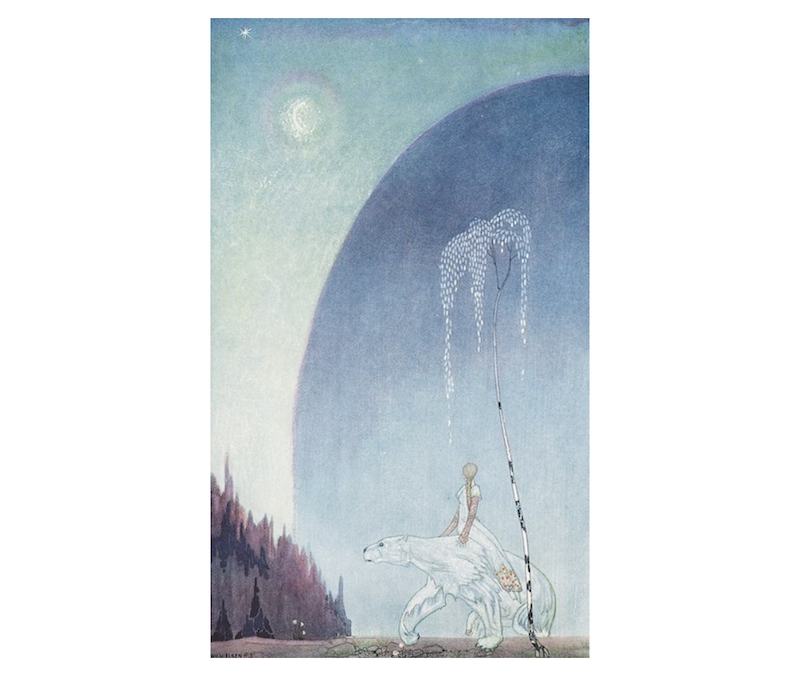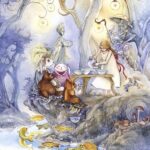“Can you tell me the way then, so I can find you!”
“Yes, you may try,” said he; “but there is no way thither. It lies east of the sun and west of the moon, and never would you find your way there.”
“I will, because I will seek you.”
East of the Sun, West of the Moon is a Norwegian fairytale written around 1890. Like most other tales, it comes from oral folk traditions, and there are many earlier variants such as Beauty and the Beast, and the Black Bull of Norroway. All these have their birth place in the Greek myth of the eternal love between Cupid and Psyche; and what all these tales explore is the narrative of the search for the lost husband, as well as the marriage with an animal bridegroom, all of which you can read about in my essay Wild Marriage.
Animal bridegroom narratives can be traced back to 4,000 years. Two worlds meet, they touch, they kiss, and find that love is not only something felt in the hearts, it is known by the hands also. And yet sometimes the lovers can’t be together in the long term because somehow they can’t reconcile their different worlds. Other times, love does win after all; and despite being from different worlds the lovers reunite. This reunion and ability to reach deep intimacy though, can only be once the lovers take off their masks, their false skins, and fall in the trust and radical self-honesty through some transformation. And while the transformations in tales are portrayed as external, the truth is that it always begins in the inner emotional and spiritual wildlands.

East of the Sun, West of the Moon, Illustrated by Kay Nielsen
East of the Sun, West of the Moon
Perhaps it all begins with a dream, born of the depth of our heart’s desire, and then sent like a song, a soul’s longing, for the one whose heart will hear it too.
At least this is how I always think meaningful stories start.
East of the Sun, West of the Moon begins with a white polar bear approaching the house of a poor peasant and asking him for his daughter’s hand in marriage; in exchange for her hand, the bear will give him many riches.
From the first moment she saw him, the girl knew the bear had come for her. How many times had she dreamt of him, of riding on his back, sleeping wrapped safe in his paws, walking beside him? How many times, on their terrifying journey, had she imagined the bear walking beside her, guarding her family while they slept? Now he was here, as if spelled from her dreams.
And so they set off; the beautiful girl climbed on the bear’s back and they left into the wilderness.
“Don’t be afraid,” the bear would tell her, “I’ll take care of you and protect you, from all strong winds and storms and freezing weathers, just hold on tightly to my back and take comfort in the warmth of my coat.”
Eventually they reached the bear’s castle, which was a beautiful glorious castle, and the girl lived there with all comforts and tender caring for her needs. Each night, unknowingly to the girl, the bear would turn into a man and come into the bedchambers of his wife to sleep beside her; though he always told her that it is forbidden to turn on the lamp for she was not meant to ever see him.


East of the Sun, West of the Moon, Illustrated by P J Lynch
As nights and days went on, and the words of other people reached her, the girl became more and more worried why she wasn’t allowed to turn on the lamps. If they truly loved each other, why are there such secrets? Who was she really sharing her bed with? What if it was a troll who is dangerous and would harm her?
So she hid a candle, and in the middle of the night held the lamp to her husband, only to uncover that he was a most attractive and handsome young man. Spilling three drops of tallow on his shirt, the man woke up in fear,
“If only you’d been patient my love … My witch step-mother put a curse on me and if had you restrained your curiosity until one year had passed, the curse would have been lifted. But now I must go to the impossible place at east of the sun, west of the moon, and marry the bride that’s been chosen for me who is her daughter – a troll.”

Illustration by Kay Nielsen
“I am sorry my love please forgive me. But I will seek you, I will always seek you even to this impossible place until I find you ….”
When the prince vanished, the girl wept and wept, but with the courage that the passion of our heart gave her, she began her journey into the wilderness towards the unknown lands to east of the sun, west of the moon.
Many years passed, and many pages of the story pass as well if you read the book, and through them all the girl endures many hardships; but with a kindness of rhythm she learns patience, and in each seemingly meaningless step, we find that greater significance lies as it turns out that it gives her just what she needs to take the next step.
At last, after any years, she finds the castle of the prince, where he is getting ready to marry the witch’s daughter, the troll.
Overjoyed to her and finally be reunited with the woman of his heart, they embrace and think of a plan to outwit the troll and get married.
In the morning and calmly he told the troll that he wished to be married in his stained shirt from the candle wax.
“I bid you to wash it for me, my dear bride to be, for I will only wish and desire to marry the woman who will clean the stains.”
The troll agreed because she thought it’d be a simple task and she wanted to please the desires of him – but when she began to wash the shirt, the stains became dirtier and dirtier. She pleaded with the prince that it is impossible for the shirt to be washed and he shouted, “What do you mean impossible? Do you not love me? Even the beggar at the gates can wash it!” The troll, irritated and somewhat humiliated because her ego was hurt, said, “Well okay then, let’s see if the beggar can wash them!”
The beggar of course was the girl who had been the prince’s one true love all along. She was naturally able to easily wash the stains away, as it was always his destiny to marry only her.
To the ancients, the bear symbolized ressurection, and the connection of women to the cycles of the land. In winter, she would go into hibernation and its heartbeat would descrease to almost nothing. Often times the male would impregnate the female right before hibernation, and yet perhaps miraculously, the egg and sperm would not unite immediately. They float and dance separately until the approaching of spring. And then, at the end of her winter’s sleep, they would unite so that her cubs are born in the wamth of spring and she could feed them as she awakens – to provide them with the nurturing, caring and attention that they need to grow healthily.
This is a profound metaphor for our lives and for the importance of knowing how to tune our bodies to the cycles of land, both lands of our inner and outer realm. In relationships too, there are times for quietness, and there are times for intentional initiation. What could be seen as a dry empty phase, would only be followed by spring and the newness of the blossoming – from seeds planted before yet knowing that all needs time to grow with a patience and kindness of rhythm, and with trust in life ,and with trust in oneself and the other. It’s a natural unfolding but what is meant for us will never pass us by.
In the psyche, the bear often symbolizes our own ability to navigate through our emotional wildlands, and to regulate our own feeling life. The bear power is in the ability to move in cycles, be fully alert and aware, and when needed to quiet down into a hibernative sleep – the higher purpose of which is to renew our energy for the next cycle and phase of life. It also offers us insight on the ability to be both/and: both patient and initiative, both generous and fierce, both tender and resilient, both kind and protective. We make our boundaries known clearly, we protect our territories, and we shake the skies when we need to; yet we remain fair, compassionate and accessible at all times.
Relationships always go through their own phases but if we learn to pay attention to our beloved every day, then we can always re-learn and re-discover the kissing, the holding and the caring. Every marriage has its wild parts; the wild within us and the wild parts of our partners. There is an allowance and acceptance that we’ll never fully know another, but that’s okay. Our inner worlds too change as we change but we can always stay curious and explore one another like art, seeing beautiful new angels and shades every day.
When two worlds meet, they touch, they kiss, and we find that love is not only felt in the hearts, it is known by our hands also.
Just as in animal bridegroom narratives, some lovers cannot reconcile their different worlds, while others do. And then there are those who sometimes lose each other, but somehow, someway, they find their way back, and are able to not only reconnect but to actually finally build something true and real. This reunion however comes only after a time of self-reflection, transformation and radical self-honesty.
Spiritual development isn’t for the faint of heart, but real love too isn’t for the faint of heart.
Love is a greedy kingdom that demands all of us, every part, it’s a complete dissolution of self as we take another in our heart and in our life.
Blood of my blood, bone of my bone, I give you my heart, I give you my vow, our hearts beat as one, our souls again kiss as one, from time before time beyond time, a love as past lives, as now, as always and forever, and then after, again.
In Margaret Atwood’s poem, Habitation, she beautifully portrays the ways in which a marriage is both a challenge and an opportunity for a deepening.
The poem is basically stating that the idea of marriage is still almost primitive to us. It is something humans cannot really understand and need to work at because it is not quite natural to us. She emphasizes the need to dedicate our effort into one another and the need to build our marriage from the ground up.
The core of marriage expressed in the poem is that it must be based only on love, not on physical trappings like the ideas of house or the white picket fence. These are not what binds a couple for a lifetime. What binds us in love is our ability to adapt in any climate and adjust through the changing shapes as we walk along the wilderness.
And sometimes learning, or re-learning, to build our fire, as primitive as it may sound, is actually the path forward and towards each other.
And where is this east of the sun, west of the moon?
It is the whisper of the trees, the unknown horizons towards which your eyes shift, as if you are looking for something, waiting for something, seeking something, yet perhaps you don’t even know what yet. It is the calling you towards itself, with a voice older than us, and more ancient than time. It is the things you feel attracted to, as if they have possessed your soul since childhood, things which feel familiar more than one life should allow.
It is the knowing of your heart; the knowing that somewhere beyond the mountains, beyond the seas, is the one you were made for, just as he was made only for you. To reach this place, this place where your heart belongs, you just have to trust, listen and follow it.
This article features excerpts from my essay Wild Marriage, and is part of my series “The Story Threads” where I discuss the various layers of famous tales, lore and myth, and how it all relates to our modern world. Previous posts in these series include What Donkeyskin Knows, What Cinderella Knows, What The Snow Queen Knows, What Sleeping Beauty Knows, What Rapunzel Knows, The Gift of the Magi, The Dandelion Girl, What Snow White Knows, Beauty and Her Beast, Weaving Life, Bluebeard, Étaín, and many more that you can find in my folklore + myth section.

For more of my writings, browse through my Art of Love.
If you wish to support me and my work, you may do so by sharing it or donate here. For personal readings with me, you may visit my Offerings.
Your support means so much to me! Thank you wholeheartedly!
Cover illustration by Kay Nielsen, “East of the Sun, West of the Moon”.




